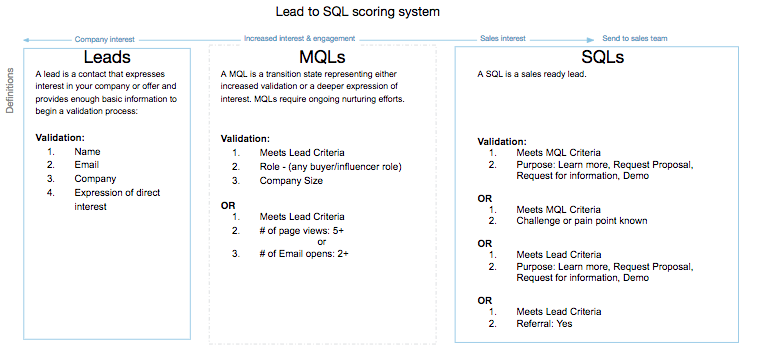
B2B Articles - August 11, 2018
By

How would you describe a marketing campaign’s success? Do you simply show your CEO an attractive new website page, or do you track leads and sales?
Research suggests marketers are still choosing to allocate marketing dollars to create “pretty” instead of creating “results”. With only a glance at marketing statistics compiled in 2018, a self-assessment seems to be in order.
Only 61% of marketers believe their marketing strategy is effective. 40% of marketers say proving the ROI from their marketing activities is their top marketing challenge. And, nearly 80% of companies are not meeting their revenue goals. (HubSpot)
The future of marketing is forcing marketing leaders within B2B organizations to ask themselves and speak to, how do we grow the business?
At its core, marketing is meant to increase sales and grow a business. Is your marketing strategy aligned with that core purpose? Take a quick step back and audit your current marketing efforts with these three questions.
Did metrics immediately come to mind? Without clear business metrics, your marketing efforts will not yield demonstrable results. It’s the saying “what gets measured, gets managed”. As marketers, you must tie your efforts back to business metrics that matter.
Are your campaigns set up to generate results that tie directly to your business goals? Or is focus elsewhere?
It’s likely that if your current marketing efforts are directly tied to your business goals, growth is the focus and you are increasing the lead pool and quality of leads with buyer-centric campaigns. If, however, you are focused on business-centric efforts (company announcements, product launches) you are likely depleting your marketing dollars quickly on activities that require large budgets, long production cycles and tasks with limited buyer-driven insights, yielding your business a minimal if any return on investment.
We recommend communicating regularly to ensure your team stays aligned and on board. Whether you are a manager, marketer, assistant or even the agency partner, the business objective should be top of mind so that strategic as well as execution-oriented work is always tied to delivering insights to grow the business.
Your self-assessment answers will help answer the question, “how growth-driven are you?”. If you are like many marketers, there is room for improvement.
Take a look at the list below.
(Check all that apply.)
Related Reading: B2B Lead Generation: How to Set Measurable Goals
All the efforts described above will support business growth and many organizations are on the right track when it comes to setting goals. 70% of companies say “converting leads to customers” is their top marketing priority over the next 12 months. (HubSpot)
But to increase revenues and grow the business, a marketer needs information. Many marketers are still using legacy marketing tactics to run their business that provide little in return. In fact, 74% of companies that weren’t exceeding revenue goals did not know their visitor, lead, MQL, or sales opportunities.
That’s a critical sales and marketing alignment problem. And aligning sales and marketing is one goal has the potential to yield significant and demonstrable growth, making all your other efforts more effective..
Sale and marketing, or “smarketing”, is a hot topic that will most likely become the future of marketing. It offers a shockingly large growth opportunity that will directly impact your bottom line.
HubSpot states, “Organizations with strong alignment between sales and marketing teams achieve 20% revenue growth on average annually. By contrast, companies with poor alignment saw revenues decline by 4%.”
Related Reading: Benefits of Integrating Sales and Marketing
One of our clients recently highlighted just how essential sales and marketing alignment is for business growth. Despite multiple expensive - and successful - lead-generation projects, they still couldn’t grow their business because they were missing the first, crucial element of sales and marketing alignment: lead classification.
Our client’s problem with sales and marketing alignment became clear when they asked us to help them become more strategic. They tasked us with bringing ideas to the table for how they could grow their business for the upcoming year. Nothing was off limits but they had 2 specific goals.
With business growth the goal, we set out as partners to identify strategic opportunities and deliver our recommendation for the first step.
Having previously worked with them only on projects, we hadn’t taken a good step back and audited their business and the multiple brands they had under an umbrella from a holistic perspective.
Upon review, the strategic recommendation came into immediate focus. Lead generation efforts were consistently increasing their lead pool. Great news! However, nurturing campaigns for the leads didn’t exist. Lead classification didn’t exist. Our large B2B client didn’t know what lifecycle stage their enormous amount of leads were in.
Without creating lead classification criteria, marketers lose out. They miss the opportunity to send leads relevant pieces of content that could truly influence their decision to buy. Furthermore, the marketing strategy for how you build campaigns, spend budgets and allocate resources has to be based on historical experiences and subjectivity.
But it doesn’t end there. Without lead classification, marketing teams will typically transfer all leads to sales. According to HubSpot, a shocking 62% of B2B marketers do - regardless of how qualified they are.
It’s this process that leads sales teams to de-prioritize or even ignore the leads their marketing team brings in. It’s also why many marketing teams often hear “these are not good quality leads” from their sales team.
Whether you are in a situation similar to our client, with a healthy lead pool that you know very little about, or just starting out, aligning with sales starts with lead classification.
With lead classification, you will learn from the sales team what they consider to be “sales ready”. You’ll also learn what your sales team uses to understand a prospect. And, the actual process of defining lead classification criteria with your sales team is not only the first step towards unifying the departments but also the step that has the potential to position your business for explosive growth.
Here’s how.
Lead classification allows a marketing team to know:
Lead classification allows a sales team to know:
Lead classification also highlights for both marketers and sales teams where the focus should be to grow the business. This communication allows for closer alignment, creating a closed loop of information and ultimately a win-win for the teams and business.
Time, energy and budgets are allocated towards launching campaigns that drive growth with the business metrics that matter.
1.) Demographic Information
What insights could be collected through lead generation efforts to demonstrate great lead quality? List the demographic criteria for the lead that is important to your business. This could
2.) Behavioral Activity
What is the lead activity that would ensure the lead is sales ready? Have they visited your site once or multiple times? Have they download an educational piece of content or requested pricing information? List the behaviors that will tell you how interested someone is in your company. This could include: email opens and click-throughs, social engagement or content downloads.
3.) Buying Process / Interest
What are the pain points, needs, motivations, challenges and interests of the lead? Identifying buyer frustrations will allow Marketing and Sales to speak directly to why a buyer should care during the buying process and help accelerate the buyer through the buyer’s journey. This could include: the current solution isn’t effective, there are challenges with getting things done or they don’t have the right strategy in place.

Let Data Guide Your Strategy
Growth-driven marketers know efforts should be tied to business goals and be capable of producing insights. Data should guide the strategy, playing a role behind all efforts with the forethought that marketing can then pass along these insights to sales. Marketing strategists should ask what new insights they can uncover through campaigns that are built to engage with the organization’s target audience. For example, “If it doesn’t produce a sales-ready lead, at a minimum what data-driven insights do we plan to uncover?”
Marketing teams can uncover:
Related Reading: How to Use Marketing Data for B2B Company Growth
With powerful insights, you’ll never have to be in a meeting again where you speak to creating “pretty” instead of “results”. As a growth-driven marketer, you’ll have the information you need to classify leads, nurture them until they’re ready to talk to sales, and improve your ability to speak to your campaigns’ ROI.
Leaders will have a team focused on growth and marketing campaigns driving towards their business objectives.
Your team will consistently ask themselves “Is this strategy or work I’m doing going to generate insights and results that will be meaningful to the business goals?”
And, best of all, marketing and sales will be unified and in position to directly impact the business’ bottom line.
Source: Zoominfo: blog.zoominfo.com/sales-and-marketing-alignment-statistics/
Source: HubSpot: hubspot.com/marketing-statistics
Source: State of Inbound: https://www.stateofinbound.com/

Tel 212-993-7809
Ironpaper ®
10 East 33rd Street
6th Floor
New York, NY 10016
Map
New York Agency
B2B marketing
B2B Content
Demand generation agency
Digital Marketing
Account-Based Marketing
ABM for SaaS
ABM for energy
Demand generation campaigns
Industry marketing
Privacy Policy
First-party data marketing
SaaS marketing
SEO for B2B
IoT Marketing
B2B Marketing for IoT Companies
HubSpot Agency
B2B Product Marketing
B2B Software Marketing
IoT go-to-market strategy
IT Marketing
HubSpot for ABM
ABM for AI companies
Technology Marketing
Marketing for IT Companies
ABM Campaigns
B2B lead generation
B2B Marketing and Growth Agency.
Grow your B2B business boldly. Ironpaper is a B2B marketing agency. We build growth engines for marketing and sales success. We drive demand generation campaigns, ABM programs, B2B content, sales enablement, qualified leads, and B2B marketing efforts.